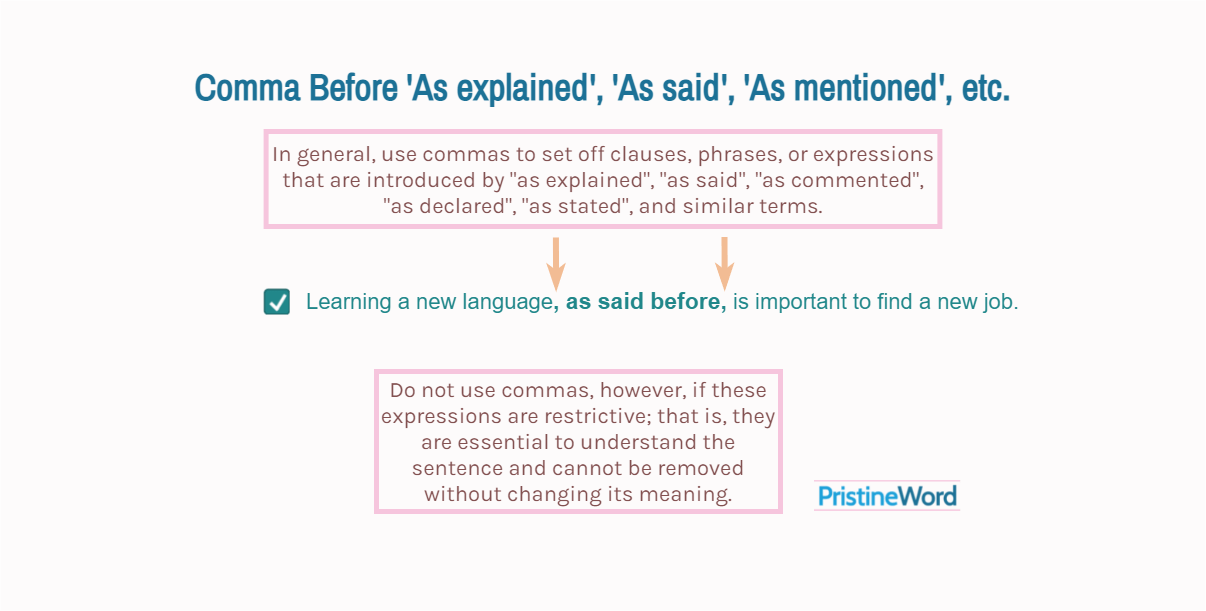In general, use commas to set off clauses, phrases, or expressions that are introduced by "as explained", "as said", "as commented", "as declared", "as stated", or similar terms.
In general, use commas to set off clauses, phrases, or expressions that are introduced by "as explained", "as said", "as commented", "as declared", "as stated", or similar terms.
Learning a new language, as said before, is important to find a new job.
Learning a new language as said before is important+ to find a new job.
Do not use commas, however, if these expressions are restrictive, that is, if they are essential to understand the sentence and cannot be removed without changing its meaning.
Contents
1. When to Enclose 'As explained', 'As mentioned', etc. in Commas
We typically use "as mentioned", "as explained", and similar terms as introductory phrases, explanatory notes, or interrupters (phrases that interrupt the sentence flow). They help clarify the context of your writing, but can be easily omitted without changing the essential meaning of the sentence. Consequently, they should be enclosed by commas.
The inflation rate, as reported by the Bureau Of Labor Statistics, rose to its highest level since 2018.
Note that we can remove "as reported by the Bureau of Labor Statistics" without changing the basic meaning of your sentence:
The inflation rate rose to its highest level since 2018.
Generally, we should use commas to set off phrases or expressions that do not define or restrict.
As explained in section 3 of this report, copper’s conductivity is likely to have a positive impact on global energy efficiency.
They were impressed by the story, as I explained to Claire in the email I sent to her last night.
If "as explained", "as predicted", "as mentioned", "as reported", etc. come at the start (or at the end) of a sentence, the period replaces a comma.
As I mentioned above, avocados and olives are powerful antioxidants.
Crime is becoming a serious concern, as reported by the Crime Statistics Agency.
2. Exceptions
As stated above, we usually need a comma before and after expressions like "as explained", "as said", "as suggested", etc. to provide details or contextual information. However, you can also use these elements to introduce restrictive phrases; that is, part of a sentence that defines or limits.
Examine these examples:
The apocalyptic event didn't happen, as predicted by James White.
The apocalyptic event didn't happen as predicted by James White.
Careful writers and readers understand that:
- the first sentence means that James White said that the prediction was going to fail, while
- the second sentence conveys that James White made the failed prediction.
Therefore, do not separate with commas restrictive phrases, including expressions like "as explained", "as noted", "as described", etc., when being used as groups of words that limit or define.
3. Alternative Punctuation
Instead of using commas, you can enclose expressions like "as suggested", "as outlined", "as stated", "as explained", etc. in parentheses to clarify or use them as an aside.
The main reason behind this (as explained to us) is that excessive sugar consumption is linked to weight gain.
Similarly, you can replace commas by em dashes to indicate added emphasis or an interruption.
The use of cryptocurrencies—as mentioned by our expert—is not unusual these days.
4. More Examples
- As explained by the author, China is experiencing structural and economic changes.
- The situation is, as described by our experts, really dramatic.
- Follow the instructions, as outlined above, to confirm your order and install the product.
- As I said before, most of us fall in love in our 20s.
- The real reason why we can't move faster than the speed of light, as explained by a range of physicists, is that once we are advancing entirely through space, there is no more speed to be gained.
- As mentioned earlier, there is a service charge of 10%.
- As stated earlier, these terms are irrelevant and ambiguous.
- The rationale behind this behavior, as explained to us, is simply that people hate being embarrassed.
- In India, you get tired as soon as you wake up because of the pollution, as a renowned Indian Engineer said.
- As commented before, this is the list of countries that can trade with Japan with minimum restrictions.
5. Conclusion
Follow these simple guidelines to determine whether to use a comma before or after expressions like "as explained", "as said", "as mentioned", etc
- Use a comma before and after these phrases when using them as introductory elements, interrupters, or explanatory notes.
- Do not place a comma when using these expressions as restrictive elements, that is, if they are important to understand the meaning of the sentence because they define or limit.

